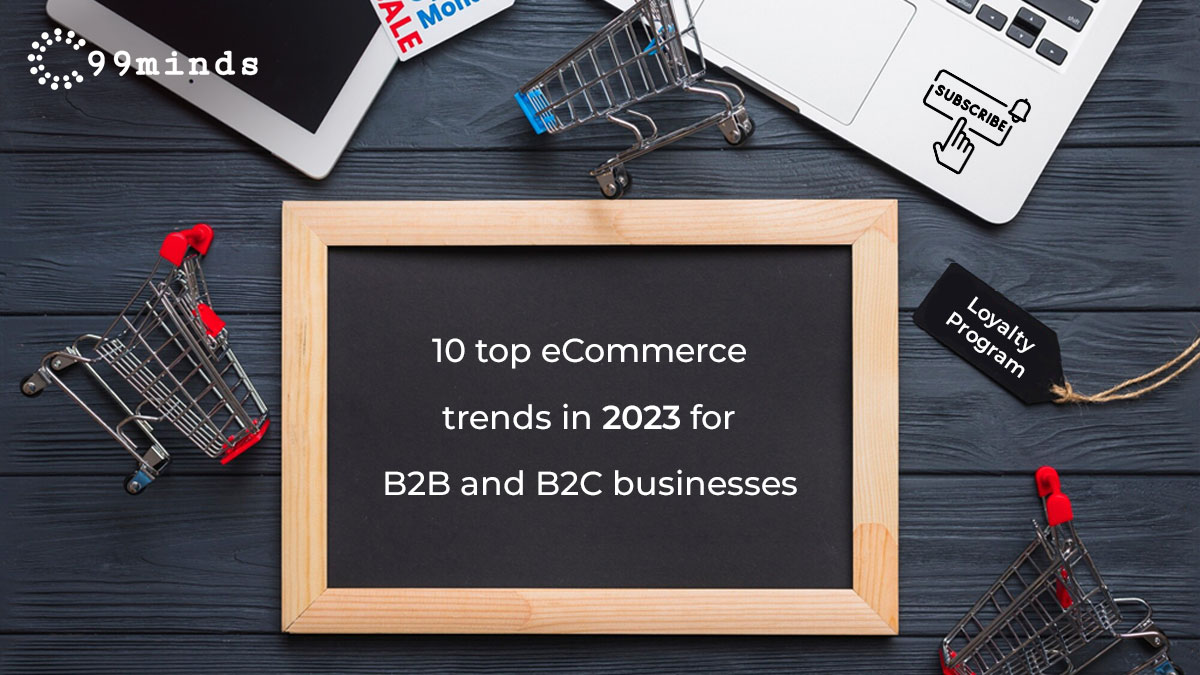
PRAVIN KAMBLE

The rise in the number of online shoppers and the continued rise in digital payments is no cause for surprise. The fast growth has led to a rise in competition among eCommerce firms, and they are investing in tools and resources to stand out from the crowd. Otherwise, it is easy to be swept away in a sea of eCommerce stores.
Online retail sales are expected to reach $6.51 trillion this year, and eCommerce stores might take up 22.3% of it.
eCommerce businesses must work on offering a seamless journey for their customers. Providing high-quality products is only one part of the story. Several things must fall into place to have a thriving eCommerce business.
If you are an eCommerce store owner, here are the top 10 eCommerce trends in 2023 for B2B and B2C businesses:
If there is one constant in the world of retail, it is the need to provide a greater level of customer service. From offering chatbots for immediate service to free returns, customers these days want you to vie for their attention and business. With dime-a-dozen eCommerce stores present, you have to offer nothing but the best to keep your customers hooked.
Even the simplest of things create a tectonic shift in your brand in the minds of your customers. For example, offer extra convenience or free shipping to increase their chances of buying from you.
The Buy Online Pick up In-Store strategy is great for consumers who want to buy from the convenience of their homes and pick up the product at a place close to their homes. They don’t have to wait for the traditional delivery system to collect the order. In this method, the customers can check the product during pickup and return it if they think it is damaged or not what they expected. The chances of the product getting stolen after delivery become nil.
BOPIS also offers eCommerce retailers the opportunity to upsell and cross-sell. The shipping costs are reduced since they don’t have to reach the houses of each customer.
The opportunity for customers to communicate with your business through multiple channels is one of the best aspects of customer service. It is not a luxury anymore since every customer expects it these days. As of now, around 52% of eCommerce retailers have omnichannel capabilities. It is one of the easiest ways to retain customers.
You will be able to provide an excellent shopping experience to your customers using omnichannel communication by understanding them deeply.You must research the channels they use and how they use them and have a clear idea about the buyer’s journey.
Legacy technologies can no longer be used for B2B and B2C eCommerce transactions. Your customers expect a superior level of service, which can only be facilitated with the help of the latest technologies. To ensure that you are at par with your competitors, take a holistic audit of the tools and technologies that you are currently using. Upgrade one piece of technology at a time so that the entire system works properly.
A dedicated eCommerce platform with capabilities like integrated enterprise resource planning, customer relationship management, and so on are pivotal for a seamless customer experience.
Even though B2C selling is closely associated with social commerce, B2B stores are keen to be present on social sites. 46% of buyers use social media to research for solutions. These days, besides promoting the brand and building awareness, social media sites can also be used as storefronts. It allows customers to buy directly without leaving the social media site.
With Covid-19 drastically reducing the purchasing power of people worldwide, it is no wonder that many customers are switching to buying from thrift stores or are open to buying refurbished goods. It is also partly due to an increased interest in sustainability. Second-hand eCommerce is popular in categories such as clothing, bags, books, shoes, etc.
B2B eCommerce stores offer self-service options throughout the buyer’s journey. They allow users to find answers to questions, schedule appointments, submit inquiries, etc. It provides an opportunity for the customers to check out the various options available, without having to get on a call with a sales representative. Businesses can start with simple self-service options such as tracking orders or accepting payments.
If there is one mistake that most businesses around the world consistently do is to ignore their existing customers. Retaining your existing customers is cheaper than trying to acquire new customers. The ones that are happy with your service will be easy to upsell and cross-sell. eCommerce store owners should also prioritize working on existing relationships and improving customer loyalty and retention.
Customer loyalty is one thing that is almost non-existent among eCommerce customers. Since there is hardly any differentiation in the products sold in eCommerce stores, most people would prefer stores that offer them the best bang for the buck. That’s precisely why businesses need to invest in a loyalty program for their customers. It results in stronger brand allegiance, higher profits, and easier customer acquisition.
The average American consumer belongs to 16.7 customer loyalty programs. It is important that you design your loyalty program in such a way that it hooks your customer into being a part of it. Some of the most popular loyalty programs are points, tiered loyalty, paid, and universal loyalty programs. The right rewards for your customers depend on what they are looking for. You can only do that by concentrating on data and analysis, and for that, it is best to use loyalty program software.
Recurring customer purchases to your eCommerce store is one of the best ways to have a cash cow. Amazon Prime is an excellent example of subscription commerce. Amazon’s customers are happy paying a premium because of their extra perks– Prime Music, Prime Gaming, and One-day delivery; you name it.
It provides predictable and recurring revenue, grants access to valuable customer data, and increases the average order value and customer lifetime value. Even customers love the subscription model since it provides a balance between price and value.
Wrapping up:
No matter the latest trend, eCommerce stores should ensure that they do not provide customers with a below-par experience. Find several ways to attract customers to your site, but also develop strategies to engage and retain them. eCommerce stores that keep in touch with the latest trends and realities of the eCommerce world would be in a great position to rule the year 2023 with big revenues.
For eCommerce businesses that are looking to grow in the year 2023 with a powerful loyalty program, we are here to help you. The 99minds team is adept at equipping you with a customer engagement and retention platform that can help you drive loyalty and increase revenue.